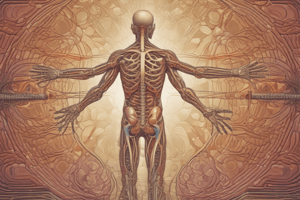Podcast
Questions and Answers
A person experiences a sudden drop in blood pressure while standing up. Which of the following mechanisms would be the most immediate compensatory response?
A person experiences a sudden drop in blood pressure while standing up. Which of the following mechanisms would be the most immediate compensatory response?
- Increased parasympathetic nervous system activity
- Increased sympathetic nervous system activity (correct)
- Activation of the renin-angiotensin-aldosterone system (RAAS)
- Increased secretion of atrial natriuretic peptide (ANP)
Damage to the cerebellum would most likely result in which of the following deficits?
Damage to the cerebellum would most likely result in which of the following deficits?
- Inability to experience emotions
- Impaired coordination and balance (correct)
- Loss of the ability to understand language
- Loss of short-term memory
Which of the following best describes the role of the hypothalamus in hormonal regulation?
Which of the following best describes the role of the hypothalamus in hormonal regulation?
- Directly stimulating target tissues via motor neurons
- Controlling blood glucose levels through insulin secretion
- Releasing hormones that control the anterior pituitary gland (correct)
- Regulating blood calcium levels through calcitonin secretion
A researcher is studying a neuron and observes that it consistently fails to reach threshold, even with significant stimulation. Which of the following is the most probable cause?
A researcher is studying a neuron and observes that it consistently fails to reach threshold, even with significant stimulation. Which of the following is the most probable cause?
In a negative feedback loop regulating body temperature, which of the following represents the effector?
In a negative feedback loop regulating body temperature, which of the following represents the effector?
What is the most likely effect of damage to the dorsal root ganglia?
What is the most likely effect of damage to the dorsal root ganglia?
Following a car accident, a patient reports being unable to feel touch on their left arm, but motor function is normal. Where is the most likely location of the injury?
Following a car accident, a patient reports being unable to feel touch on their left arm, but motor function is normal. Where is the most likely location of the injury?
Which of the following describes a key difference between the anterior and posterior pituitary glands?
Which of the following describes a key difference between the anterior and posterior pituitary glands?
Why are steroid hormones able to directly influence gene expression in target cells, unlike peptide hormones?
Why are steroid hormones able to directly influence gene expression in target cells, unlike peptide hormones?
A person is diagnosed with a condition that causes a chronic overproduction of cortisol. Which set of symptoms would most likely be observed in this patient?
A person is diagnosed with a condition that causes a chronic overproduction of cortisol. Which set of symptoms would most likely be observed in this patient?
Flashcards
Somatic Nervous System
Somatic Nervous System
Controls voluntary movements via skeletal muscles; includes pathways like the corticospinal tract.
Autonomic Nervous System
Autonomic Nervous System
Regulates involuntary functions (e.g., heart rate, digestion) through sympathetic (fight or flight) and parasympathetic (rest and digest) branches.
Hormones
Hormones
Chemical messengers secreted by endocrine glands that travel through the bloodstream to target cells, influencing various physiological processes.
Feedback Mechanism
Feedback Mechanism
Signup and view all the flashcards
Neuroplasticity
Neuroplasticity
Signup and view all the flashcards
Cerebellum
Cerebellum
Signup and view all the flashcards
Somatosensory Cortex
Somatosensory Cortex
Signup and view all the flashcards
Sensory Transduction
Sensory Transduction
Signup and view all the flashcards
Sensory Adaptation
Sensory Adaptation
Signup and view all the flashcards




